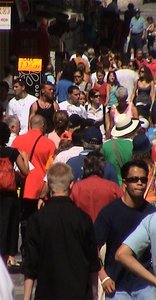Sampling and Fieldwork

The sampling
For each Standard Eurobarometer survey new and independent samples are drawn. Starting with Eurobarometer 32 (October 1989) the basic sampling design in all member states is a multi-stage, random (probability) one. The sampling is based on a random selection of sampling points after stratification by the distribution of the national, resident population in terms of metropolitan, urban and rural areas, i.e. proportional to the population size (for a total coverage of the country) and to the population density. These primary sampling units (PSU) are selected from each of the administrative regions in every country. Starting with Eurobarometer 32 NUTS regions are applied for almost all member countries [see EUROSTAT introduction to NUTS - Nomenclature of territorial units for statistics, classification server and classification history incuding download of NUTS classifications 1995 to 2013].
In the second stage, a cluster of addresses is selected from each sampled PSU. Addresses are chosen systematically using standard random route procedures, beginning with an initial address selected at random. In some countries respondents were randomly selected from electoral registers, such as Great Britain (until Eurobarometer 35), Republic of Ireland and Luxembourg (until Eurobarometer 32). At least initially, Sweden was using a random sample bought at the government census bureau. In each household, a respondent is selected by a random procedure, such as the first birthday method. Up to two recalls are made to obtain an interview with the selected respondent. No more than one interview is conducted in each household. In the case of special target groups or oversamples the sampling procedure may differ (e.g. quota sampling).
In previous Eurobarometer surveys up to Eurobarometer 31A (June 1989), different sampling methods were used which varied between countries. The sampling designs were either multi-stage national probability samples or national stratified quota samples. In each country a random selection of sampling points was made in such a way that all types of area (urban, rural, etc.) are represented in proportion of their populations. The choice of respondents was made in a second stage. In Belgium (up to Eurobarometer 23), Denmark, Luxembourg, and the Netherlands a random selection from suitable population or electoral lists (of individuals or households) was used, in Belgium (starting with Eurobarometer 24), France, Italy, United Kingdom, and Ireland quota sampling established by sex, age and occupation on the basis of census data, in Greece, Spain and Portugal a random route procedure. Germany used quota sampling established by sex, age and occupation on the basis of census data until Eurobarometer 23 and random route starting with Eurobarometer 24 (October 1985). For the surveys up to Eurobarometer 7 sampling information is not available.
In all Eurobarometer member countries, fieldwork is conducted on the basis of detailed and uniform instructions. Equivalent basic bilingual questionnaires (English/French) are developed and translated into the other relevant languages. Back-translation control is applied. TNS Opinion describes the translation as a multistage process, starting from the master questionnaire finalised by TNS and translated by the local partner institutes. Proof reading and back-translation - after interim adaptation through the institutes - is performed by independent translators, followed by central checks, local changes and final approvement through TNS.
Two (or more) language versions are used in Belgium, Luxembourg, Finland, and starting with Eurobarometer 62 (October 2004) in Spain, Estonia, Latvia, Malta and Turkey.
There is also copyright information on Eurobarometer questionnaires provided.
Interviews for Standard and Special Topic Eurobarometer are conducted face-to-face in respondents' homes. By way of exception in Sweden interviews for Eurobarometer 42 have been carried out by telephone. As far as the data capture is concerned, the use of CAPI (Computer Assisted Personal Interview) was for the first time documented for Eurobarometer 62 and "for those countries where this technique was available".
Starting with autumn 2004 (Eurobarometer 62) the Standard Eurobarometer are run and coordinated by TNS opinion (formerly TNS Opinion & Social), a consortium formed by Taylor Nelson Sofres (TNS) and EOS Gallup Europe.
Between autumn 1998 (Eurobarometer 32) and spring 2004 the fieldwork was carried out by national institutes associated with INRA (International Research Associates) EUROPE - European Coordination Office in Brussels. INRA EUROPE was also responsible for the co-ordination and the production of the integrated data sets, starting with Eurobarometer 54 in co-operation with GfK in the new European Opinion Research Group EEIG. Until Eurobarometer 31A, the fieldwork was carried out by national organizations belonging to the European Omnibus Survey (EOS-GALLUP Europe). The surveys were then coordinated and integrated by 'Faits et Opinions' in Paris.
All participating institutes are members of the "European Society for Opinion and Marketing Research" ESOMAR and comply with its standards.
